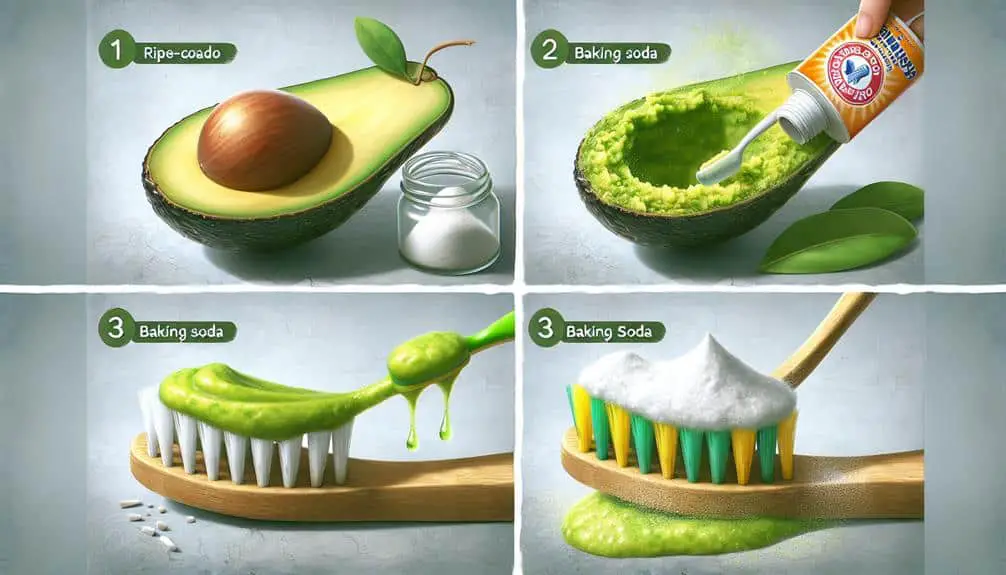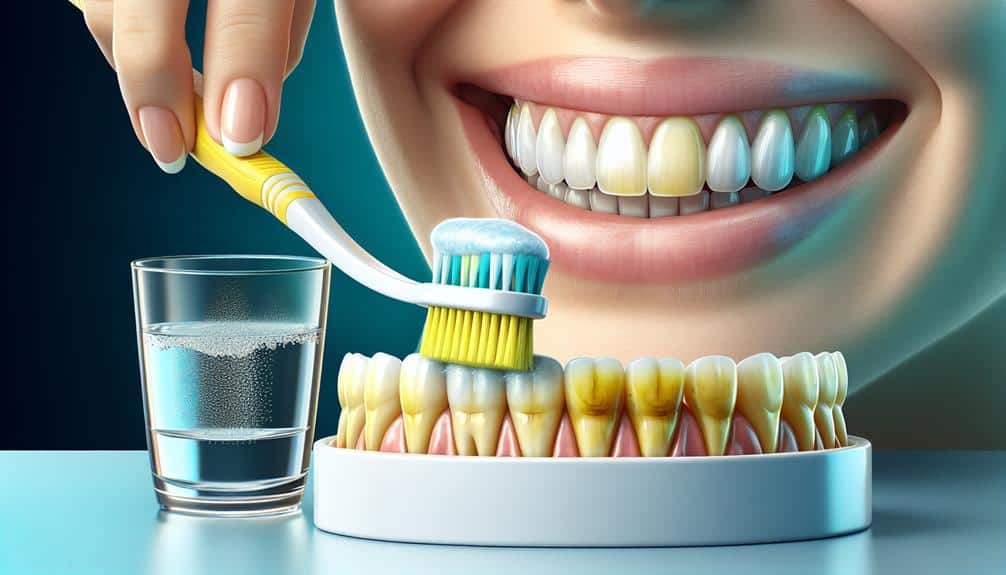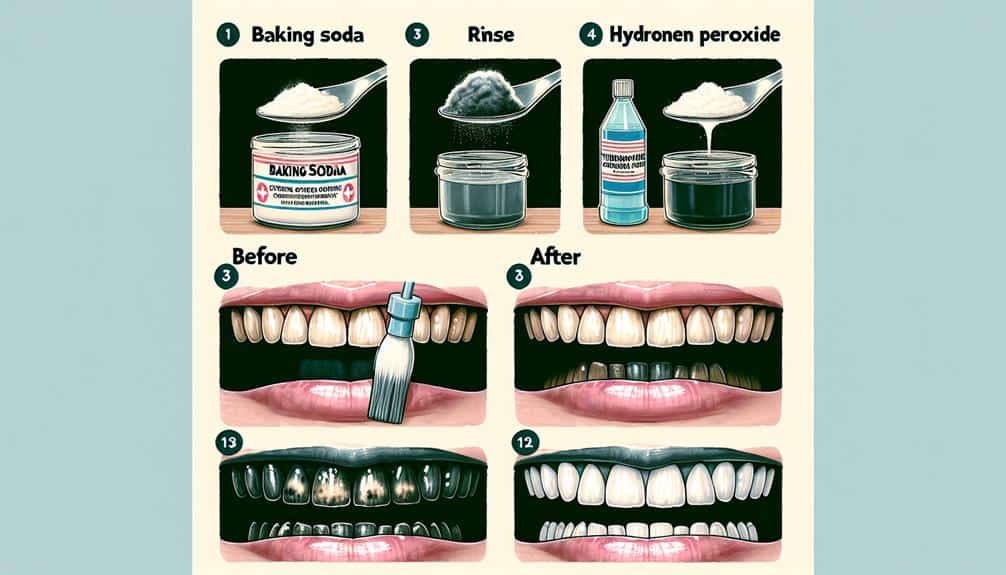To remove tetracycline stains naturally at home, try these remedies: Lemon Juice and Baking Soda work well with citric acid and abrasiveness. Hydrogen Peroxide Rinse is an antiseptic that breaks down stains. Coconut Oil Pulling enhances oral health by reducing bacteria. Apple Cider Vinegar Rinse's acidity helps diminish stains. Activated Charcoal Paste binds to toxins for stain removal. These solutions can bring back your teeth's natural whiteness. Further details on each method can offer you more insights into tackling tetracycline stains effectively.
Key Points
- Lemon juice and baking soda effectively remove tetracycline stains with natural bleaching and abrasive properties.
- Hydrogen peroxide rinse breaks down stains and reduces bacteria, aiding in teeth whitening.
- Coconut oil pulling improves oral health by reducing bacteria and plaque, promoting gum health.
- Apple cider vinegar rinse diminishes tetracycline stains with its acidic nature, enhancing oral health.
- Activated charcoal paste gently lifts stubborn stains from enamel, promoting a brighter smile.
Lemon Juice and Baking Soda
For optimal removal of tetracycline stains at home, you may want to consider using a combination of lemon juice and baking soda. Lemon juice, renowned for its citric acid content, offers natural bleaching properties that can assist in lightening stains on teeth. When mixed with baking soda, which serves as a mild abrasive, this blend can help in scrubbing off surface stains effectively. The citrus advantages present in lemon juice can aid in breaking down the discoloration caused by tetracycline, while baking soda's benefits include neutralizing acids and eliminating plaque.
To prepare this solution, blend a small quantity of lemon juice with baking soda to create a paste. Apply the paste onto a toothbrush and delicately brush your teeth for approximately two minutes. Subsequently, thoroughly rinse your mouth to eliminate any residue. It's crucial to bear in mind that while this approach can be effective, it should be used sparingly to prevent excessive wear on the enamel.
2. Hydrogen Peroxide Rinse
Consider incorporating a hydrogen peroxide rinse into your oral hygiene routine as a potential method for addressing tetracycline stains on your teeth. Hydrogen peroxide is a well-known antiseptic agent that has been used for various oral care purposes. When used as a rinse, hydrogen peroxide can help whiten teeth by breaking down stains and reducing bacteria in the mouth, contributing to improved oral hygiene.
To make a hydrogen peroxide rinse, mix equal parts of 3% hydrogen peroxide and water. Swish this solution around in your mouth for about 30 seconds, being careful not to swallow it. Spit out the rinse and then rinse your mouth with plain water. It's recommended to use this rinse no more than once a day.
While hydrogen peroxide can be effective in removing surface stains, it's essential to use it cautiously to prevent any potential damage to the teeth or gums. Incorporating this rinse into your oral hygiene routine along with regular brushing and flossing can aid in teeth whitening and maintaining good oral health.
3. Coconut Oil Pulling
For addressing tetracycline stains on your teeth, one effective method to contemplate is coconut oil pulling. This ancient technique involves swishing a tablespoon of coconut oil in your mouth for about 15-20 minutes on an empty stomach. The oil's natural properties can help combat tetracycline stains and improve your overall oral health.
Coconut oil pulling offers various oral health benefits. It can potentially reduce harmful bacteria in the mouth, decrease plaque buildup, and even help with gum health. The lauric acid found in coconut oil has antimicrobial properties that may contribute to a healthier mouth environment.
To perform the oil pulling technique effectively, take a tablespoon of coconut oil and swish it around in your mouth, ensuring it reaches all corners for 15-20 minutes. Afterward, spit out the oil (do not swallow it) and rinse your mouth with water before brushing your teeth as usual.
Incorporating coconut oil pulling into your oral hygiene routine may aid in addressing tetracycline stains and promote better overall oral health.
4. Apple Cider Vinegar Rinse
Considering its potential benefits for addressing tetracycline stains, utilizing an apple cider vinegar rinse may offer a natural solution to enhance your oral health. Apple cider vinegar is known for its vinegar benefits, commonly used in hair care for its ability to remove buildup and restore shine. When used as a rinse, its acidic nature may help break down the stains caused by tetracycline antibiotics, gradually reducing their appearance on teeth.
To create an apple cider vinegar rinse, mix one part apple cider vinegar with two parts water. Swish this solution around in your mouth for about a minute, ensuring it reaches all areas of your teeth. Spit out the rinse and then brush your teeth as usual.
Additionally, while apple cider vinegar can be beneficial in skincare routines, its acidic properties can erode tooth enamel if used excessively. Hence, it's recommended to use this rinse sparingly, perhaps a few times a week, to avoid any potential damage while working towards diminishing tetracycline stains.
5. Activated Charcoal Paste
To further address tetracycline stains, explore the efficacy of utilizing an activated charcoal paste as a potential remedy for enhancing oral health. Activated charcoal, known for its adsorbent properties, has gained popularity in teeth whitening due to its ability to bind to toxins and stains on the teeth's surface. When used as a paste, activated charcoal can help remove tetracycline stains by absorbing the compounds causing discoloration.
Incorporating activated charcoal paste into your oral hygiene routine can aid in gently lifting stubborn stains from the enamel, promoting a brighter smile. To create the paste, mix a small amount of activated charcoal powder with water to form a thick consistency. Gently brush the paste onto your teeth, allowing it to sit for a few minutes before rinsing thoroughly.
While activated charcoal can be effective in teeth whitening, it's essential to use it sparingly to avoid excessive abrasion on the enamel. Remember to consult with a dental professional before trying any new teeth whitening methods to make certain they're appropriate for your oral health needs.
Frequently Asked Questions
Can Tetracycline Stains Be Completely Removed With These Natural Remedies?
You can't completely remove tetracycline stains with natural remedies alone. Professional treatments offer more effective solutions. Consider long-term efficacy when choosing between natural alternatives and professional intervention. Implement preventive measures to maintain oral health.
Are There Any Potential Side Effects or Risks Associated With Using These Remedies for Tetracycline Stain Removal?
When contemplating natural remedies for tetracycline stain removal, potential risks might include skin irritation or allergic reactions. Assure safety by patch testing and consulting a healthcare provider. While effectiveness varies, cautious experimentation can gauge efficacy.
How Long Does It Typically Take to See Results From Using These Natural Remedies?
Typically, results from these natural remedies start showing in about 2-4 weeks with regular use. Consistent application frequency is key for expected outcomes. Visible improvements vary but often become noticeable within the first month.
Can These Remedies Be Used in Combination With Professional Dental Treatments for Tetracycline Stain Removal?
Yes, professional treatments can be combined with natural remedies for tetracycline stain removal to enhance effectiveness. While professional treatments may come at a cost, the benefits of faster and more noticeable results are often worth it.
Are There Any Specific Dietary or Lifestyle Changes That Can Help Prevent Tetracycline Stains From Forming in the Future?
Embrace a rainbow plate, savoring vibrant veggies and fruits. Elevate oral hygiene with diligence. Shield your smile by avoiding tetracycline culprits, like certain antibiotics. Craft a lifestyle that nurtures prevention strategies for future dental woes.



